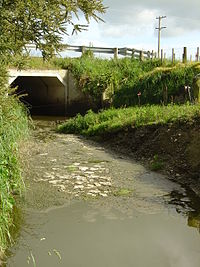
Photo from wikipedia
Abstract Currently, heavy metal (HM) contamination in greenhouse soils is a significant concern due to the rapid expansion of greenhouse agriculture. However, it is difficult to accurately assess HM pollution… Click to show full abstract
Abstract Currently, heavy metal (HM) contamination in greenhouse soils is a significant concern due to the rapid expansion of greenhouse agriculture. However, it is difficult to accurately assess HM pollution in greenhouse soils in China due to the lack of local geochemical baseline concentrations (GBCs) or corresponding background values. In the present study, the GBCs of HMs in Dongtai, a representative greenhouse area of China, were established from subsoils using cumulative frequency distribution (CFD) curves. The pollution levels of HMs and potential ecological risks were investigated using different quantitative indices, such as geo-accumulation index (I geo ), pollution index (PI), pollution load index (PLI) and ecological risk index (RI), based on these regional GBCs. The total concentrations of six metals (Cd, Cr, Cu, Ni, Pb and Zn) in surface soils were determined and shown to be lower than the concentrations reported in other greenhouse regions of China. The GBCs of Cd, Cr, Cu, Ni, Pb and Zn were 0.059–0.092, 39.20–54.50, 12.52–15.57, 20.63–23.26, 13.43–16.62 and 43.02–52.65 mg kg −1 , respectively. Based on this baseline criterion, Cd, Pb and Zn accumulated in the surface soils because they were present at concentrations higher than their baseline values. The soils were moderately polluted by Cd according to the I geo values, and the PI results indicated that moderate Cd contamination was present in this area. The large variation of I geo value of Cd revealed that Cd in this area was likely influenced by agricultural activities. The PLI showed that most of the study area was moderately polluted. However, an analysis of the RI showed that the investigated HMs had low ecological risks. Correlation analysis and principle component analysis suggested that the Cd, Pb and Zn in the greenhouse soils mainly originated from anthropogenic sources (agricultural activities, atmospheric deposition etc.), while Cr, Cu, and Ni originated from natural sources. The findings of this study illustrated the necessity of GBC establishment at the local scale to facilitate more accurate HM evaluation of greenhouse soils. It is advisable to pay more attention to Cd, which could cause environmental problems in the greenhouse system.
Journal Title: Ecological Indicators
Year Published: 2017
Link to full text (if available)
Share on Social Media: Sign Up to like & get
recommendations!